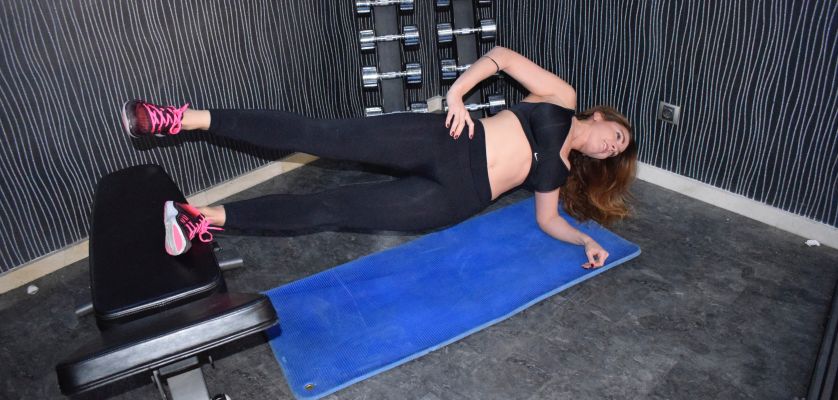Iliotibial band syndrome, also known as iliotibial band or"runner's knee," is one of the most common running ailments today and also one of the least understood.
You may be interested in: 6 Iliotibial Band Syndrome Recovery Exercises
While almost all physical therapists and doctors who have had some experience with this or other running ailments know how to treat iliotibial band, most runners have no idea how to do it. When it comes to experiencing the symptoms of this syndrome most people would resort to the following alternatives:
- Place ice packs on the sore area.
- Perform some stretching exercises before and after exercise.
- Use the foam roller on the affected area, with the pain that this can produce.
- Total rest.
However, if we questioned the runners who have practiced some of the above alternatives, they would tell us that as soon as they started running again, the syndrome also returned. Iliotibial band syndrome does not respond to the treatments mentioned above; it is not an inflammation, so ice will not work, and it is not a muscle contracture, so the massager will not be the solution.
But then, what really works, we will now analyze the structure of the injury to discover its true nature.
What causes iliotibial band syndrome?
The iliotibial band is a thick piece of connective tissue that runs parallel to the femur from the hip to the knee. This tissue attaches along the gluteus maximus and the tensor fascia lata to the side of the hip until it reaches the lateral side of the tibia. One of its main functions is to stabilize the knee while running.
Iliotibial band syndrome is diagnosed when pain is present at the insertion point of the band, which is located on the lateral outer side of the knee. This pain is commonly caused by compression caused by an abnormal motion pattern of the femur.
So what causes the femur to move abnormally? Usually, a weak buttock. The gluteus maximus and gluteus medius are the two main muscles that control pelvic position and leg stability during the running cycle. A weak hip also contributes to the pelvis "dropping" over the leg. The position of the pelvis is of utmost importance, as when the pelvis moves in an unfavorable position, the iliotibial band is directly affected.
Iliotibial band syndrome is therefore a problem caused by an excessive and inadequate movement of the pelvis that must be controlled. How to control this movement? By strengthening the supporting musculature so that it is able to handle the force of the impact that occurs during running. While strength exercises are incredibly beneficial, these are generally the least utilized strategy.
Exercises for iliotibial band syndrome.
Strengthening the hips and glutes is the most effective treatment for iliotibial band syndrome. These muscles will control the rotation of the femur, the position of the pelvis and ensure that the iliotibial band is not compressed or pushed by the hip.
Here are a series of exercises designed specifically to treat iliotibial band syndrome, the only equipment needed is a rubber band to add extra resistance.
Lateral leg raises
Lie on your right side and raise your left leg to 45 degrees in a controlled manner, then slowly lower your leg back to the starting position. Make sure that the pelvis does not move, always keeping it in a neutral position.
For more resistance, the elastic band can be placed around the ankles.
- Do 20 to 30 repetitions with each leg.

Leg openers
Lying on one side, knees and ankles together, bend the knees 90 degrees; in this position we will open the legs by activating the gluteus muscles. Only the knees should be separated from each other during the opening, the heels should remain together throughout the exercise.
We must also make sure not to move the pelvis, keeping a neutral position of the back. To add resistance, the band can be placed just above the knees.
- Perform 20 to 30 repetitions on each side.


Hip raises
Lying on your back with your knees bent and your arms resting at the sides of your body, raise your hips to a straight diagonal position between your knees and chest.
The upper back should not separate from the floor. Then we will gently lower our hips back to the starting position. To increase the difficulty we can raise one leg so that all the weight rests on the other.
- We will perform 20 to 30 repetitions.


Lateral hip bridge
Lying sideways on the floor, place your feet on a chair, one foot on top of the other; keeping your feet in this position and your body sideways, raise your hips until you reach a straight position. Try to keep your back straight all the time. Return to the original position.
- Repeat this movement 10 to 30 times.


Side walk
Standing, we will slightly bend our knees to achieve a half squat position, in this position we will take 10 steps to one side and then 10 steps to the other, this is one repetition.
- We will perform 3 to 5 repetitions.
For a more advanced version we can place the elastic band around the ankles, this should be tight enough to provide resistance throughout the range of motion.

One-legged squats
Standing on one leg we will perform a squat, lowering just enough so that the thigh is in a position parallel to the floor. Try to keep your back as straight as possible and perform the movement in a controlled manner, making sure that the knee does not destabilize.
- Do 5 to 15 repetitions with each leg.



Hips down
(NOTE THIS EXERCISE MUST BE DONE UNDER THE SUPERVISION OF A PROFESSIONAL)
We will stand on the right leg, with the pelvis in a neutral position, we will "drop" the left side several centimeters lower than the right side. When performing this movement we should feel that the right hip muscle receives contraction. Then return to the original position.
- Repeat this movement 10 to 30 times and then change legs.
The following should be taken into account when performing these exercises:
If we already suffer from iliotibial webbing syndrome, we must perform the exercises leaving a day of rest in between.
Modify the number of repetitions or rest longer between each exercise if necessary due to pain.
If you do not yet have the syndrome, these exercises can be performed once a week as a preventive measure.
If bands are used, choose medium resistance bands at the beginning and change them as the exercise becomes easier.
It should be remembered that this routine is not a complete treatment program for iliotibial band syndrome, but for most runners with a mild case of iliotibial band syndrome, it will help them return to training within 1-2 2. For more severe cases, physical therapy is necessary.
Now to get stronger, stay healthy and good luck with your injury!
Read more news about: Nutrition











